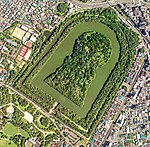Inaridai Kofun Group
- View a machine-translated version of the Japanese article.
- Machine translation, like DeepL or Google Translate, is a useful starting point for translations, but translators must revise errors as necessary and confirm that the translation is accurate, rather than simply copy-pasting machine-translated text into the English Wikipedia.
- Consider adding a topic to this template: there are already 1,082 articles in the main category, and specifying
|topic=will aid in categorization. - Do not translate text that appears unreliable or low-quality. If possible, verify the text with references provided in the foreign-language article.
- You must provide copyright attribution in the edit summary accompanying your translation by providing an interlanguage link to the source of your translation. A model attribution edit summary is
Content in this edit is translated from the existing Japanese Wikipedia article at [[:ja:稲荷台1号墳]]; see its history for attribution. - You may also add the template
{{Translated|ja|稲荷台1号墳}}to the talk page. - For more guidance, see Wikipedia:Translation.
The Inaridai Kofun Group (稲荷台古墳群) is a Kofun cluster [ja] or a group of Kofun located in the Chiba Prefecture.[1]
Findings
The cluster includes Inaridai Kofun No. 1 Kofun, which is the kofun the Inaridai Sword was taken from.[2] Some of the earliest pottery in the Kantō region has been found in this Kofun, giving its name to the type.[3]
Location
Located on the west of the Bōsō Peninsula and just east of Tokyo, Inaridai is part of a concentration of early archaeological sites, which also includes Shakujii, in Tokyo's Nerima ward among others. Northeast of these locations are the later sites, categorized as Proto-Jomon. These Proto-Jomon sites are distinguished by pottery that predominantly features fiber or cord impressions.[1]
In the Miura Peninsula, pottery has shell marks. In the Western Kanto Plain, pottery changed from fiber marks to cord marks. Inaridai is a key site in this change.[1]
Usage in periodization
The Kofun cluster gives its name to Inaridai pottery, the oldest pottery type in the Kantō region.[3]
The Inaridai No. 1 Kofun and the Inaridai Kofun group are found in the Kanto loam layer. This layer has both early Jomon pottery types like Inaridai, Haijima, and Tado I and other artifacts.[3] It is also used as a categorization for figurines.[4] and other implements.[5][6]
In the Kanto valley of Japan, the Inaridai is some of the oldest pottery found. It has a special rolling marking on it. Experts aren't sure where this marking method came from. Wu[who?] thinks it might have started as a useful feature before becoming just for decoration. The Inaridai pottery dates back to just after the start of the proto-Jomon period. This makes it important for studying early Japanese pottery.[7]
See also
- Proto-Jomon period
- Miura Peninsula
- Hashihaka Kofun
- Makimuku ruins
- Ukikunden
- Inariyama Kofun
- Furuichi Kofun Cluster
References
- ^ a b c Kidder, J. Edward (1952). "Review of The Prehistory of Japan". Artibus Asiae. 15 (3): 288–292. doi:10.2307/3248573. ISSN 0004-3648.
- ^ Pearson, Richard (1990). "Review of Protohistoric Yamato: Archaeology of the First Japanese State". Harvard Journal of Asiatic Studies. 50 (2): 768–775. doi:10.2307/2719219. ISSN 0073-0548.
- ^ a b c Kidder, J. Edward (1954). "A Reconsideration of the "Pre-Pottery" Culture of Japan". Artibus Asiae. 17 (2): 135–143. doi:10.2307/3249085. ISSN 0004-3648.
- ^ Maringer, J.; Kidder, J. Edward (1957). "Review of The Jomon Pottery of Japan, J. Edward Kidder, Jr". Artibus Asiae. 20 (2/3): 206–207. doi:10.2307/3249384. ISSN 0004-3648.
- ^ Yampolsky, Philip (1951). "Review of Historical Studies in Japan, 1949". The Far Eastern Quarterly. 10 (4): 392–396. doi:10.2307/2049017. ISSN 0363-6917.
- ^ Tamburello, Adolfo (1962). "Review of Japan Before Buddhism Italian edition: II Giappone prima del Buddhismo". East and West. 13 (4): 377–383. ISSN 0012-8376.
- ^ Tolstoy, Paul (1953). "Some Amerasian Pottery Traits in North Asian Prehistory". American Antiquity. 19 (1): 25–39. doi:10.2307/276410. ISSN 0002-7316.
- v
- t
- e
- Yamatai locations
- Himiko
- Legend of Himiko
- Wa
- Wajin
- Sea People












